

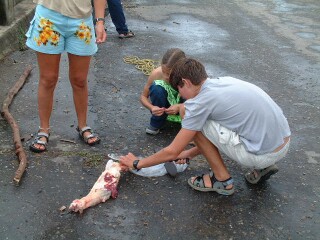 We
got up early the next morning, for there was a long day planned. We ate a superb
breakfast and got ready to leave. As we packed up our stuff and began stowing it
away, Beatrix surprised us all by asking to accompany us on the rest of our
trip. We had room, and nobody had any objections, so we welcomed her to come
with us. She grabbed her stuff and stored it in the van along with ours, and
climbed into a seat along with the other girls. When we were all ready, we drove
out of the camp and down into the lowland part of Los Llanos.
We
got up early the next morning, for there was a long day planned. We ate a superb
breakfast and got ready to leave. As we packed up our stuff and began stowing it
away, Beatrix surprised us all by asking to accompany us on the rest of our
trip. We had room, and nobody had any objections, so we welcomed her to come
with us. She grabbed her stuff and stored it in the van along with ours, and
climbed into a seat along with the other girls. When we were all ready, we drove
out of the camp and down into the lowland part of Los Llanos.
We stopped once to buy food
for lunch and another time to buy a leg of beef from a butcher. After that, we
drove down into the real Llanos (Los Llanos means The Plains,) a large area of
flatlands. Small tropical trees were visible in some areas, but most places
there was nothing growing taller than a medium sized bush. The grass was very
tall in some places, and it looked like just about all of the ground was wet.
Indeed, wide and slow moving rivers covered a surprising area of the plains.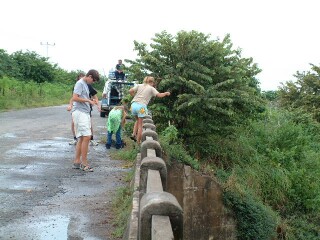
Alan had the driver stop at a bridge over one of these rivers. He dug out a fishing tackle box, took the beef leg and a machete, and showed us how to fish for piranha. First, small hooks are needed, as even the largest carnivorous piranha is only at most eight inches long, and most are much smaller (there are far more species of herbivorous than carnivorous piranha, and some of the herbivores are much bigger.) Second, he used the machete to cut off a small piece of beef, preferably with some gristle attached. Given the choice, very small (two to three inch) piranhas would eat all the meat without hooking themselves, but only the bigger fish could eat a lump of gristle, and they needed to swallow the hook to do it. Third, Alan just took the bait and a few yards of line and threw them in the water. There was no need to make a great cast; the piranha swarmed to wherever there was food. However, sometimes a particularly large fish would sit in one area, and the bait needed to land near it or others would claim it first. Fourth, he explained that the first nibbles must be completely ignored, because the tiny piranhas would always try to get their share, and could cause the line to jerk around without ever getting the hook in their mouths.
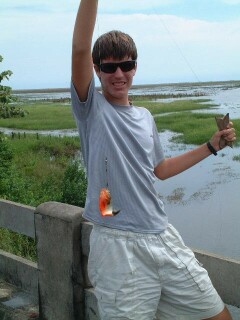 We
all got to work trying to catch dinner, as Alan said that they could be grilled
up for a meal if we caught enough. The little fellows were certainly voracious;
any meat that landed in the water was gone in seconds, and the piranhas would
eat anything with blood on them, even chopped up pieces of other piranhas.
Hooking them wasn’t always easy though. The biggest ones could bite through
the line, and the small ones could not get the hooks inside their mouths. Even
once hooked, they were not always easy to land, but when they were in hand, it
was very satisfying to throw them down on the pavement and knock them senseless.
We each caught several piranhas, including Beatrix, who actually did very well.
When Alan’s bag had about a dozen fish in it, some of which continued to flop
and wiggle even after a few hard encounters with the asphalt, he went to get a
length of rope. Using the rope, he hoisted the leg bones, with their few scraps
of remaining meat, and then dropped them in the river with the rope still
attached. The fish went completely wild! Holding the rope, I could feel the
jerks and shakes of the fish attacking any meat left on the bones. After only a
few minutes in the water, Alan lifted the bone and held it for us to see. There
was no meat or gristle anywhere, and the bones themselves showed many small
tooth marks.
We
all got to work trying to catch dinner, as Alan said that they could be grilled
up for a meal if we caught enough. The little fellows were certainly voracious;
any meat that landed in the water was gone in seconds, and the piranhas would
eat anything with blood on them, even chopped up pieces of other piranhas.
Hooking them wasn’t always easy though. The biggest ones could bite through
the line, and the small ones could not get the hooks inside their mouths. Even
once hooked, they were not always easy to land, but when they were in hand, it
was very satisfying to throw them down on the pavement and knock them senseless.
We each caught several piranhas, including Beatrix, who actually did very well.
When Alan’s bag had about a dozen fish in it, some of which continued to flop
and wiggle even after a few hard encounters with the asphalt, he went to get a
length of rope. Using the rope, he hoisted the leg bones, with their few scraps
of remaining meat, and then dropped them in the river with the rope still
attached. The fish went completely wild! Holding the rope, I could feel the
jerks and shakes of the fish attacking any meat left on the bones. After only a
few minutes in the water, Alan lifted the bone and held it for us to see. There
was no meat or gristle anywhere, and the bones themselves showed many small
tooth marks.
With our catch stored and all of the gear back in the box, we hit the road again. This time, we were going to a capybara reserve. Capybaras, the largest rodent species currently alive, need considerable wetland for grazing, and a large area had been designated for them. Alan mentioned that we might see them outside the reserve, but we surely would inside. Even as he explained about the place, we all had our eyes out for any large shapes in the tall grass.
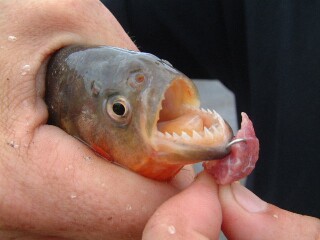 When
we were within the reserve, we all got out of the car with our binoculars and
cameras, and went down the road on foot. We spotted the first capybara quickly.
It was hard to get a good view, but we could see most of it. In body structure,
it reminded me of a four to five foot long hippopotamus. It had the same round
body, thick legs, and large head. However, it was covered in gray-brown fur like
a mouse, and had a short snout. Like hippos, they seemed to spend much of the
day at least partially submerged, if the number of wading bodies we saw was any
indication. As we walked along, I was surprised how many of the animals could be
visible in one moment, and gone the next. The high grasses grew taller than the
capybara, and sometimes hid them completely.
When
we were within the reserve, we all got out of the car with our binoculars and
cameras, and went down the road on foot. We spotted the first capybara quickly.
It was hard to get a good view, but we could see most of it. In body structure,
it reminded me of a four to five foot long hippopotamus. It had the same round
body, thick legs, and large head. However, it was covered in gray-brown fur like
a mouse, and had a short snout. Like hippos, they seemed to spend much of the
day at least partially submerged, if the number of wading bodies we saw was any
indication. As we walked along, I was surprised how many of the animals could be
visible in one moment, and gone the next. The high grasses grew taller than the
capybara, and sometimes hid them completely.
 We
saw other things than capybara that day. Birds, most in trees or flying, were
usually visible, and my mom usually had binoculars in hand. Alan turned out to
be amazingly good at identifying birds, even without using a bird book. He could
look at a raptor circling high above us, and say what it was and what markings
it would have before even looking through the binoculars, or see a cluster of
dots in a pool or tree, and tell us what kind of heron or ibis or anything else
they were. We also saw snakes on the road. The rain had gone, and the day was
hotter than I found comfortable. However, the snakes crawled out onto the road
to bask in the sun, and Alan found two. One we saw in the morning, a small
(about five foot) anaconda, and the other was a different and much smaller
species of boa that we found later in the day.
We
saw other things than capybara that day. Birds, most in trees or flying, were
usually visible, and my mom usually had binoculars in hand. Alan turned out to
be amazingly good at identifying birds, even without using a bird book. He could
look at a raptor circling high above us, and say what it was and what markings
it would have before even looking through the binoculars, or see a cluster of
dots in a pool or tree, and tell us what kind of heron or ibis or anything else
they were. We also saw snakes on the road. The rain had gone, and the day was
hotter than I found comfortable. However, the snakes crawled out onto the road
to bask in the sun, and Alan found two. One we saw in the morning, a small
(about five foot) anaconda, and the other was a different and much smaller
species of boa that we found later in the day.
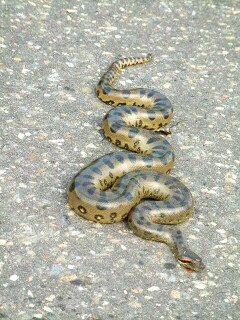 We
spent the rest of the daylight driving. Alan entertained us with jokes and
stories while we looked at the lush scenery going by outside. In the evening, we
came across a group on horseback and stopped to chat for a while. However, we
had to hurry onwards towards our final destination that day; we had a nighttime
boat trip to take, and it was getting towards dinnertime as well.
We
spent the rest of the daylight driving. Alan entertained us with jokes and
stories while we looked at the lush scenery going by outside. In the evening, we
came across a group on horseback and stopped to chat for a while. However, we
had to hurry onwards towards our final destination that day; we had a nighttime
boat trip to take, and it was getting towards dinnertime as well.
One of the modifications to the usual plan that Alan had suggested so we would avoid sharing any of the camps with different groups was that instead of a six hour boat ride to see the Los Llanos river animals, we would take two tours, one after dark and one at dawn. The first we took that evening, before dinner. Once all of our clothing and such was moved to the large and well mosquito netted room where we would sleep in hammocks (my parents had mattresses on the floor,) Alan called us down to the riverbank.
The Apure River, a major tributary of the Orinoco, is wide and slow, with muddy banks that are a great habitat for wildlife. The boat was long, perhaps thirty feet, and made of aluminum. It looked like it had been modeled on a dugout canoe, but designed with a sturdy transom to support an outboard. This boat had a seventy horsepower outboard, fitted with a powerful searchlight, and seats for two people stretching across the narrow hull. Alan sat near the bow, with a flashlight (many of us had lights with us, though the light powered by the engine was far more powerful,) and a driver sat in the back with the searchlight and engine controls. Alan also had a cooler of drinks and some snack food, since it was well passed sunset and none of us had eaten dinner.
We saw very little in our first few minutes on the river, as the town that stretched along the bank scared away many of the animals. The only wildlife I noticed in the first few minutes, aside from insects, was an herbivorous piranha that leapt over the side of the boat and landed at my feet. However, the boat was very fast, and we quickly came to an undisturbed section of river. Here, the driver slowed the boat and dimmed the light, and Alan scanned the bank for animals. It did not take long to spot some glowing red dots, the reflections of our lights from a caiman’s eyes. Caimans, a small kind of crocodile, are common in South America, but I had never cruised a river at night, seeing the red shine reflecting from their eyes. At one point, Alan had the driver go in close to the bank, where he jumped off and wrestled something off a branch. When he brought it back to the boat, we saw it was a boa constrictor. Its eyes shone orange (not red, like a caiman’s,) which was how Alan had spotted it. He explained that there was a venomous snake, the fer-de-lance, which was almost impossible to tell from the one he was holding. For a long time he had not known the difference, until somebody showed him that the eyes of the poisonous snake did not glow. After returning the snake to its tree, we continued further along the river. Alan told us he was hoping to find a small caiman that he could pick up and hold for us to see, but so far, all the ones we had been able to approach closely were too big.
 After
a little more motoring, we entered a much smaller river where hoatzin birds
supposed roosted. These birds, which are very evolutionarily primitive, eat
fruits and then have them ferment in their stomachs to aid in digesting them.
Because of this, they always smell a little like rotting fruit. The young are
born with wing claws like prehistoric birds, though they lose the claws as they
get older. They are noisy during the day, making a ‘chacka’ like sound. As
we drifted past the trees, we could smell them before we could see them. Alan
found the some in the dark trees and pointed them out to us. We also saw other
birds in the branches, some close enough to photograph with the camera’s
flash. Most of the birds were sleeping, but bats were out, eating the mosquitoes
that converged on us whenever we sat in one place for too long. After looking at
the hoatzins for a while, we motored back out onto the main section of the
Apure.
After
a little more motoring, we entered a much smaller river where hoatzin birds
supposed roosted. These birds, which are very evolutionarily primitive, eat
fruits and then have them ferment in their stomachs to aid in digesting them.
Because of this, they always smell a little like rotting fruit. The young are
born with wing claws like prehistoric birds, though they lose the claws as they
get older. They are noisy during the day, making a ‘chacka’ like sound. As
we drifted past the trees, we could smell them before we could see them. Alan
found the some in the dark trees and pointed them out to us. We also saw other
birds in the branches, some close enough to photograph with the camera’s
flash. Most of the birds were sleeping, but bats were out, eating the mosquitoes
that converged on us whenever we sat in one place for too long. After looking at
the hoatzins for a while, we motored back out onto the main section of the
Apure.
The next place we stopped was a small, shallow cut where we could see the eyes of some caimans. Alan had the driver nose right up to a small exposed mud bank where a young caiman was sitting. When we had moved close enough and Alan had judged that the baby crocodile was little enough, he jumped out onto the mud and grabbed the caiman. There were a few moments as the reptile struggled, and then Alan picked it up and carried it over for us to see. I had seen young crocodiles up close before, but even so it was interesting to be so close to one, especially with its eyes shining red in our lights. Alan was slowly sinking into the mud, so once everybody had looked at the caiman, he put it down on the ground. It held still fur a moment, and then ran off with a splattering of mud. By this time, Alan was partially coated in mud, so he got back in the boat and we all returned to the place where we would have dinner and spend the night.
The dinner was very good, and as promised, our piranhas had been grilled up. They were quite tasty, though it was a chore to get the meat from around the numerous bones. The rest of the dinner was superb as well, with chicken, and a root crop called yucca, though I hardly recall what I ate. I was very tired at the time, since it was after to thirty and we had had a busy day. The things I recall most clearly are climbing under the mosquito netting covering my hammock, settling into the hammock, and finding a position that kept my spine straight before falling asleep.
Top Level: Home | Destinations | Cruising Info | Underwater | Boat Guests | Ocelot | Sue | Jon | Amanda | Chris | Site Map | Make a Comment
|
If our information is useful, you can help by making a donation |
Copyright © 2000‑ Contact: Jon and Sue Hacking -- HackingFamily.com, svOcelot.com. All rights reserved.